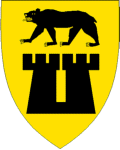Bear in heraldry


The bear is a common charge in heraldry, perhaps inherited from its totemic use among Germanic peoples[1] and by some interpreted as symbolizing strength, cunning and ferocity in the protection of one's kindred.[2] Numerous cities around the world have adopted the bear in their arms, notably the Swiss capital Bern, which takes its name from the German for bear, Bär. The bear is similarly the name-emblem of Berlin, through false etymology (Bärlein means 'small bear'), although in fact the city's name descends from a Slavic word for swamps.
The saddled bear of Saint Corbinian's legend is the heraldic symbol of Freising, Bavaria, and the Diocese of Munich and Freising. Pope Benedict XVI, former archbishop of Munich, also applied it in his Papal Arms.
In the Anglophone heraldries bears' heads, usually muzzled, are probably more common than the whole beast. But the beast itself does appear cantingly in the arms of Berwick-upon-Tweed Borough Council. A demi bear appears in the crest of Lawson in Canada. A grizzly bear, with wings, appears as a supporter in the bearings of Norris also in Canada. Canada, with a large arctic area, also unsurprisingly has armigers with polar bears in their bearings.[3] Chimerical half-bear, half-ravens appear as supporters of the Canadian Heraldic Authority.
Bears' heads are quite common in Scots heraldry (though probably not explained by the totemic use of bears by Germanic peoples), but they also turn up in other Anglophone heraldries as in the badge of the English borough of North Warwickshire; civic heraldry in Warwickshire abounds in bears (usually with staffs).
See also
- Bear#Myth and legend
- Russian Bear
References
- ↑ Pastoureau, Michel (2007). L’ours — Histoire d'un roi déchu. pp. pp. 419. ISBN 202021542X.
- ↑ The Meanings Behind the Symbols: Family Crests, Blazons, Coat of Arms, Personalized Crests
- ↑ Arms of Sylvain Bissonnette of Saint-Bruno, Quebec
| Wikimedia Commons has media related to Bears in heraldry. |
| |||||||||||||||||||

